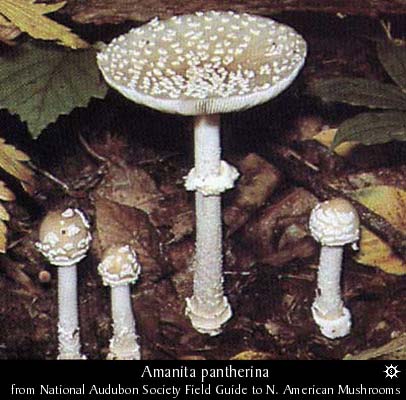(Amanita pantherina)
 DESCRIPTION:
DESCRIPTION:A. pantherina has a Cap that is 4-15 cm (2-6") in diameter, round, becoming convex to flat or slightly sunken. Its color ranges from dark to light brown, tan to dull yellowish. Often dark in the center, lightening towards to outside, and cap edges may be blackish, sooty, or yellowish-brown. Surface is tacky when wet. Its white universal veil which entirely covers the youngest mushrooms, will form white to pale buff spots or warts on mature mushrooms, and may eventually wash or wear off with age. These spots often form concentric circles, although they may also appear random. The flesh is firm and white.
The Stalk is 5-15 cm (2-6"), has a ring and a bulbous base with rows of cottony patches. It is 1-3 cm (1/4 - 1 1/4") in diameter at the base, narrowing slightly towards the cap. The stalk is white but may turn buff with age...and is usually smooth above the ring and scaly below.
The Universal Veil which causes the white spots on the cap also forms a collarlike volva...adhering to the bulb except for a free rim at the top of the bulb.
Gills are adnate to adnexed or free, close, white or pallid.
Spore Print is white. Spores are 9-13 x 6.5-9 microns, elliptical, smooth, and nonamyloid.
HABITAT:
On the ground, under conifers, pine, oak and especially Douglas-fir. Solitary to scattered or close together on ground in woods.
RANGE:
Widely distributed, but especially common under conifers from the Rocky Mountains westward. The most common of all Amanitas in the Pacific Northwest and Sierra Nevadas. Rare in the East.
SEASON:
June; September - October; November - March in California.
COMMENTS:
One of the most common causes of mushroom poisoning in the Pacific Northwest. Yellowish forms are difficult to distinguish from A. gemmata - generally they are duller and often somewhat browner at the center, but the two species appear to intergrade. The cap is never red or bright orange-yellow as in A. muscaria, and the stalk lacks the grayish patches characteristic of A. porphyria. See A. cothurnata for information on A. pantherina var. multisquamosa
Myko Web : A. pantherina


